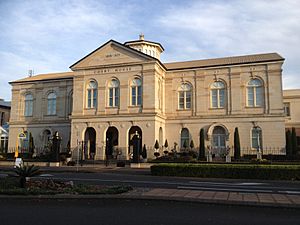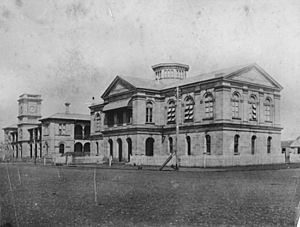Toowoomba Court House facts for kids
Quick facts for kids Toowoomba Court House |
|
|---|---|

Toowoomba Court House, 2014
|
|
| Location | 46 Neil Street, Toowoomba, Queensland, Australia |
| Design period | 1870s - 1890s (late 19th century) |
| Built | 1876 - 1943 |
| Architect | Francis Drummond Greville Stanley |
| Architectural style(s) | Classicism |
| Official name: Toowoomba Court House | |
| Type | state heritage (built) |
| Designated | 21 October 1992 |
| Reference no. | 600848 |
| Significant period | 1870s-1880s (historical) 1870s, 1910s, 1940s (fabric) |
| Significant components | roof lantern / lantern light, court house, stables, office/s |
| Lua error in Module:Location_map at line 420: attempt to index field 'wikibase' (a nil value). | |
The Toowoomba Court House is an old building in Toowoomba, Queensland, Australia. It used to be a place where legal cases were heard. The building was designed by Francis Drummond Greville Stanley and built between 1876 and 1943. It is now listed on the Queensland Heritage Register, which means it is an important historical site.
Contents
The Story of the Toowoomba Court House
The main part of the Toowoomba Court House was built from 1876 to 1878. At that time, Francis Drummond Greville Stanley was the main architect for public buildings in Queensland.
How Toowoomba Grew
Toowoomba is the main town in the Darling Downs area. This area was first explored in 1827. Later, farmers came to find good land for their animals. By the 1840s, many large farms were set up. The first town that grew to support these farms was Drayton, which is west of Toowoomba. Drayton even had the first court house in the area.
However, Drayton did not stay the main town. People thought the spot where Toowoomba is now was better because it was easier to get to from the coast. So, in 1852, plans were made for a new town called Toowoomba.
Many people supported the new town. Toowoomba grew very quickly. By the 1860s, it was the main center for farming in the Darling Downs.
Building the New Court House
Work on the new Toowoomba law courts started in 1876. This new building replaced an older, smaller court house built in 1863. The new court house was much bigger and looked more important. This showed how much Toowoomba was growing and how successful it felt.
The building was constructed in parts. The first part was finished by 1878. It cost £6870 to build. The stone used for the building came from Highfields, a nearby area.
In 1913, another building was added behind the main court house. It was used as the Lands Office. This new part looked similar to the original building, even though it used a different type of stone.
More additions were made in 1943. Another floor was added to the 1913 building. Two more two-story buildings were also added behind the 1877 building. These new parts cost £28799 and were designed by government architect R C Nowland.
What Happened Next?
In 1979, the court moved to a new building in Hume Street. The old court house was then cleaned up and restored. White paint was removed, and the stone was protected. After that, different government offices used the building. These included the Queensland Police and other departments.
In 2000, the court house was sold to a private family. With advice from the Queensland Heritage Council, they worked to restore the building while keeping its historical look.
What Does the Toowoomba Court House Look Like?
The Toowoomba Court House is on a busy corner where Margaret and Neil Streets meet. It is right next to the Toowoomba Post Office. Both buildings look similar in style and materials. These two buildings, along with the Police Station nearby, create a special area of government buildings in the town.
Main Building Features
The main part of the Court House faces Margaret Street and is made of sandstone. At the back, there are three more sections. Two of these are connected to the main building, and one stands alone. The section facing Neil Street is made of a darker stone but looks similar to the main building. The other two sections are simpler and are painted.
There are new gardens at the front of the building. The back area is paved and used for parking cars. The original stables, which were used for horses, have been rebuilt as a garage at the back.
Entering the Building
You can enter the building by walking up some shallow steps. These lead to a central area with three open arches at the front. There is also one arch on each side. This creates an open porch area on the ground floor. Inside the front arches, there are decorative wrought iron gates.
The first floor above the arches has three large windows. These windows have decorative pillars between them. Above the central part of the building, there is a triangular roof section called a gable. It has the years "1878–1979" and the words "COURT HOUSE" written on it. Behind this gable, there is an eight-sided light feature. Inside, this light is above the court room.
The sides of the main building have similar windows but without the decorative pillars. There are also doors on the eastern side.
Inside the Court House
The inside of the building has been changed a lot over time. The most original parts that are still there are the central staircase and the court room. The court room is now used as a lecture hall. It still has many original features. These include decorative iron columns that support the upper viewing area (gallery), wooden roof supports, and wooden details. It also has the eight-sided light feature above it.
Some original details like wooden doors and fireplaces can still be seen. However, new walls and changes to connect the back sections have changed the original rooms. Some interesting features that are not original include the concrete railings and stairs from 1943.
Why is the Toowoomba Court House Important?
The Toowoomba Court House is listed on the Queensland Heritage Register because it is very important for several reasons.
Showing Queensland's History
This building helps us understand how Queensland's history has changed. It was built between 1876 and 1878. It was the third court house in the Darling Downs area. Its construction shows how the region grew and developed over time.
A Great Example of Its Type
The Toowoomba Court House is a good example of a large government building from its time. From the outside, it looks grand and has a classical style. Inside, the main court room still looks much like it did when it was used for trials.
Beautiful and a Landmark
The Court House is located at a main intersection in Toowoomba. It stands out and is a well-known landmark in the town. It forms a group of important government buildings with the nearby Post Office and Police Station. Its design and the way it was built are considered very beautiful and well-crafted.
Connected to Important People
The building is also important because of its connection to architect J C Nowland. He was the person who designed the additions made to the building in 1943.


